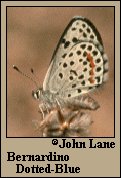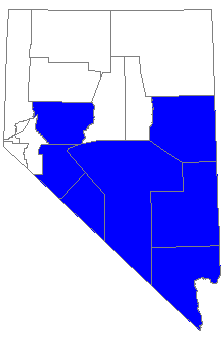 |
 

 |



Bernardino Dotted-Blue (Euphilotes bernardino [Barnes and McDunnough])
Wing span: 11/16 - 13/16 inches (1.7 - 2.1 cm).
Identification: Male blue with narrow black outer margin, no orange band.. Upperside of female brown with orange submarginal band on hindwing. Underside off-white with distinct black spots and an orange band on hindwing.
Life history: Males patrol all day near host plants to find receptive females. Eggs are laid singly on host plant flowers; caterpillars eat flowers and fruits, and are protected by ants. Chrysalids hibernate in sand or leaf litter.
Flight: One flight; February to late August , timing depends of location and host.
Caterpillar hosts: Various wild buckwheats (Eriogonum species): especially Fasciculate buckwheat, but also Cinereous and Shockley buckwheats.
Adult food: Flower nectar especially that from Eriogonum species.
Habitat: Varies by subspecies; includes desert scrub and chaparral.
Range: Southern California south to northern Baja California, southern Nevada and western Arizona.
Conservation: Main populations in southern California coastal sage-scrub are being lost to development and loss of habitat integrity. Interior populations elsewhere may be threatened by invasive cheatgrass.
The El Segundo Blue (Euphilotes bernardino allyni) is listed as an Endangered species because almost 99 percent of its sand dune habitat between Los Angeles and San Diego has been destroyed or degraded.
The Nature Conservancy Global Rank: G3, G4 - Very rare or local throughout its range or found locally in a restricted range OR Apparently secure globally, though it might be quite rare in parts of its range, especially at the periphery. Subspecies minuta Austin of Nevada is rank T1.
Management needs: Maintain habitat together with host plants of all known populations.
References:
Emmel, T.C., editor. 1998. Systematics of Western North American Butterflies.
Mariposa Press, Gainesville, Fla. 878 pp.
Emmel, T.C. and J.F. Emmel. 1973. The butterflies of southern California. Natural
History Museum of Los Angeles County, Los Angeles. 148 pages.
Garth, J.S. and J.W. Tilden. 1986.California Butterflies. University of California
Press, Berkeley and Los Angeles. 246 pp, 24 plates.
Opler, P.A. 1999. A field guide to western butterflies. Houghton-Mifflin Co.,
Boston, Mass. 540 pages, 44 color plates.
Scott, J. A. 1986. The butterflies of North America. Stanford University Press,
Stanford, Calif. 583 pages, 64 color plates.
Stanford, R. E. and P. A. Opler. 1993. Atlas of western USA butterflies including
adjacent parts of Canada and Mexico. Denver and Fort Collins, CO.
Author: Paul A. Opler
State and Regional References:
Emmel, T.C. Editor. 1998. Systematics of western North American butterflies.
Mariposa Press, Gainesville, Florida.
Layberry, R.A., Hall, P.W. & Lafontaine, D.J., 1998. The Butterflies of
Canada. University of Toronto Press, Toronto, ON. 280 pp.
Opler, Paul A. 1999. Peterson Field Guide to Western Butterflies, revised
edition. Houghton Mifflin Co., Boston, Mass.
Stanford, R.E. and P.A. Opler. 1993. Atlas of Western USA Butterflies.
Privately published, Denver, Colo.
Tilden, J.W. and A.C. Smith. 1986. A Field Guide to Western Butterflies.
Houghton Mifflin Co., Boston, Mass.

